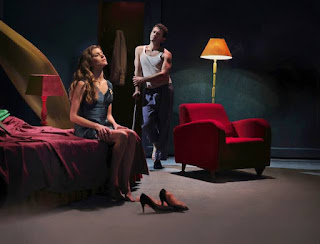Last night, I would have loved to have had a dinner date. Not so much for social balance as for having just witnessed a socio-cultural-theatrical phenomenon, and my brain was full to bursting. I have, in particular, a couple of friends knowledgable of the work of Tennessee Williams who would have been most welcome at table.
I saw an Italian production of Cat on a Hot Tin Roof (La Gatta sul Tetto Che Scotta) at Teatro Mancinelli. I needed about an hour of table talk after the final curtain and all I was able to get was a few minutes with the nice couple I shared a box with. I wrote a friend who is one of those Williams guys, but he couldn’t find a telesponder at such quick notice. Terribly short-sighted of me. I must improve.
Disclaimer; I only understood what I already know about the play and a few sentences, here and there. That’s better than anything else I’ve seen so far, but my experience of the play was primarily visual.
The set was a jewel-toned Edward Hopper painting; walls and doors of various rich greens and furniture in deep reds. Against the vast expanse of green was a yellow curtain that covered the door to everywhere, but only visible when it blossomed onto stage after someone had entered. Nifty touch. The dresses were taffeta and brightly colored, reminiscent of the fifties without being “of” the fifties. Every now and again (at what had been act breaks, as I recall) the back wall opened to reveal an overgrowth of vegetation. The curtain’s rising was immediately followed by a toy tractor of some kind making a bee line for the bed, under which it disappeared.
The acting seemed good. I especially liked Maggie and Brick. Like everything I’ve seen, the acting style tended to be operatic, and the other characters did their best not to disappoint me in that regard. The speech Big Daddy has that ends with his exclaiming that all is mendacity was delivered as a baritone aria and the audience duly applauded. I have a feeling that if Italian theater weren’t more than a little operatic, it would be so much like life as to be indistinguishable. Be that as it may.
As I mentioned, I was able to talk with my box-mates after the show. First I asked where the story was set. “In the American South, of course.” Really? “Well, actually, it was sort of generic.” Okay. Any accents? “No, pretty much standard Italian.” Even Maggie? “Maggie was just like everyone. Does she usually have an accent?” They all usually have accents. It’s just that Maggie sounded like she may have been doing one. “Really? What does the accent in English sound like?” Oh, slower than northern American English, and more musical, melodious, a little florid. “Like Italian?” Yeah, okay, like Italian. Except for the slow part. They laughed.
The interpretation was very Italian, the characters were very Italian, the relationships were very Italian, the overall concept… okay, you get the idea. To their credit, the story is actually, also very Italian, just as it sits. So maybe all this Italianità was a conscious choice. And maybe it wasn’t. I don’t remember all the character names, and there are never any programs, but the minister? Was a priest. In a cassock. And a yarmulke. Well, you know, the Catholic version. I found it so curious and kind of wonderful that in spite of all this, my box-mates completely accepted the production as having been set in the American South – until I raised my eyebrows.
Italians seem to make everything Italian. With plays, they do this to such an extent that it makes me wonder if copyright laws are enforced here, at all, or if maybe they’re just an ugly rumor. Italians do this switch to an extent I don’t think Americans do in return. I wonder if it’s because Italy has, since Roman times, been an absorbent culture, turning whoever comes here into an Italian within a generation, while in the States we allow immigrants (however reluctantly in some places, and at some times) to shape and change the overall culture. Yeah, new arrivals become American, but they stay hyphenated Americans for a long time, and yet their culinary contribution eventually ends up in the State Dining Room at The White House.
Since we’re there, let’s take dining as an example. There’s one not-Italian restaurant in Orvieto (out of dozens) and it’s Italian-Chinese. I mean, like a lot more Italian than Chinese. The most Chinese thing about it are the stone lions out front, and I suspect they were made in Viterbo. The food is probably no more strange to a native Chinese than Chinese-American is, but the extensive use of red sauce is startling. For the truly exotic, there are restaurants that specialize in cuisine not Umbrian or Classico. The Orvietan equivalent to a Samoan or Nigerian restaurant in the States, is one that features Sicilian.
Let’s now turn that phenomenon towards theatre. When Americans present an Italian (or French, or even a British) play, for example, mostly we try to honor the culture of origin, even if just a little, should it serve the play and our audience to do so. From what I’ve seen so far, Italians make it all about themselves. Not self-consciously so, but I suspect there might be riots otherwise. Okay, not actual riots, but at the very least lots of bewildered disappointment.
Of course Italians are not alone in this. Americans do that switch with movies all the time; the French hit of tens years ago is reworked into an American story with beer and garbage disposals. And Shakespeare’s stock-in-trade were stories set in exotic places, with character names from other exotic places, and all mixed in with English cultural references, and little consistency to any of it. But the thoroughness of Cat’s transition to a “typical” Italian family (however atypically dysfunctional) in a “typical” Italian situation was so utter and complete, and apparently so logical to the audience, that it left me a bit breathless. The audience seemed a bit breathless, too, and in a good way, so obviously the cultural transition worked. I don’t mean any of this as criticism, it’s just giving vent to my curiosity.
The audience was my most profound experience last night in other ways, too. That’s not to slight the actors at all, but I was following my memory of the show more than the actors’ presentation of it, so my experience of the story wasn’t as immediate as it probably was for most people.
The audience were dressed. Not over-dressed, but really well-dressed. They were excited like I remember being excited at ACT in San Francisco and am often still excited on Broadway. They watched and listened with all their hearts, and did so for more than two hours with no intermission. They were various; all ages, all types, all levels of income. They applauded at the end like they owed it to the artists to let them know they were loved, and the artists took it in like they agreed. In this town of about 5,000, there were close to five hundred people there, and it was one of two performances. To be fair, people come into Orvieto from all around the area where there is no theatre at all, but still – the surrounding towns are even smaller. At 8:30 five hundred or so people went from the theatre into a restaurant of their choice: a perfect symbiosis.
Okay about 499 did. I walked around a bit, came home, and had a sandwich. But a very good sandwich. And as American a sandwich as I could muster. And rounded it off with a tozzetto dunked in sambuca.


